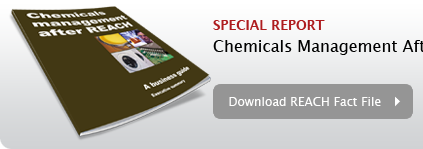REACH Guide
This Chemical Watch report is aimed at business managers who are updating their chemicals
management strategies and other personnel who need to communicate with suppliers and
customers, our business guide turns the process of REACH compliance into issues of
commercial necessity and common sense.
 Forthcoming workshop
Forthcoming workshop
Packed with case studies, the guide addresses a wide range of sectors, including chemicals production and downstream manufacturing. It will be of particular value to managers devising substance testing strategies, and those seeking to communicate with others in their companies or supply chains.
 Inside the report
Inside the report
How you and your organisation can:
|
 |
Benefit from technical appendices:
|
 |
|
See how leading firms are tackling these and other challenges and discover how industry bodies in the automotive, electronics, personal care, construction and detergents sectors are approaching the question of chemical risks. |
|||
 |
 |
 |
 |
 Report Contents
Report Contents
CHAPTER ONE
CHAPTER TWO
CHAPTER THREE
CHAPTER FOUR
CHAPTER FIVE
CHAPTER SIX
CHAPTER SEVEN
CHAPTER EIGHT
|
 |
APPENDIX ONE
APPENDIX TWO
APPENDIX THREE
APPENDIX FOUR
APPENDIX FIVE
APPENDIX SIX
APPENDIX SEVEN
ADDENDUM
|
 |
 |
 |
 |
 |


